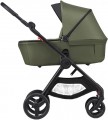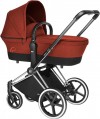Backrest tilt adjustment
The ability
to adjust the tilt between the seat and the backrest of the stroller. This helps to find the most comfortable position for the baby and adjust the seat to different situations: for example, at the end of a long walk, the backrest can be tilted back for a tired baby to take a nap.
Unit tilt adjustment
The ability to adjust
the tilt of the main unit relative to the stroller frame. This allows you to adjust the stroller to different situations: for example, at the beginning of the walk, the unit can be installed almost vertically, based on a sitting position, and later tilted back so that the baby can take a nap.
Foldable carrycot
Pushchairs in which the carrycot has a foldable design. This feature simplifies the storage and transportation of the stroller, when folded, the
foldable carrycot takes up much less space.
Carrycot carry handle
The carrycot carry handle for carrying is mounted on the carrycot and makes it easy to carry it from place to place — for example, if you need to remove the carrycot for cleaning and then put it back. The handle can have a different shape — in the form of an arc attached to the sides of the carrycot, in the form of a hood cutout, etc.
Fastening in the direction/against the movement
In strollers with this function, the seat unit can be fixed in one of
two positions, to choose from: facing the parent (against the direction of movement) or facing away from the parent (in the direction of movement). Each option has its advantages: in the first case, the baby can see a familiar face and is less nervous, and when located in the direction of movement, it is more convenient for him/her to view the world around him/her.
Depreciation
The depreciation theme is designed to absorb shocks and bumps from uneven road surfaces. The most popular nowadays are models with
spring systems; you can also meet the shock absorption of the
articulated and
double types, and in quite a large number of pushchairs this function is absent at all. Here are the main features of each option:
— Spring type. Depreciation systems based on classical springs mounted on individual wheels. They are used in all types of pushchairs except classic pushchairs (see "Design"). The simplest models use a single set of springs, while more advanced models may include additional comfort features such as SAS shock/vibration absorption technology. Whatever the case, depreciation systems of this type are simple yet practical, efficient and reliable.
— Articulated type. The type of depreciation used in pushchairs with carrycots - classic, universal, transformers. The frame, on which the carrycot or seat unit is installed, in such models is attached to the base of the pushchair with the help of special bridges, which play the role of depreciation. As bridges can be used belt hinges, such systems can also refer to the articulated. Anyway, this type of depreciation is excellent for carrycots. First of all, the pushchair is as smooth and soft as possible, which contributes to the comfort and deep sleep of the child (and the parent to
...drive the pushchair is much easier, especially on uneven surfaces). Secondly, the carrycot on such a pushchair can be rocked back and forth, lulling the baby. On the other hand, such systems are poorly suited for pushchair frames with swivel front wheels; and the failure of one absorber leads to tilting of the carrycot.
— Double. This term most often refers to the spring systems described above with additional shock absorbers on the frame of the pushchair. Such systems help to maximize vibration reduction and can approach articulated systems in terms of efficiency (see above). On the other hand, the softness of the suspension can be inconvenient when overcoming curbs and other bumps: to raise the front wheels of the pushchair, you have to press hard on the handle.
— Is absent. Pushchairs without depreciation are not suitable for uneven surfaces: in such conditions, the pushchair will be shaken violently, which creates both discomfort for the baby and inconvenience for the parent. On the other hand, such models have advantages over pushchairs with depreciation. First, due to the lack of unnecessary parts, they are much cheaper, and the design itself is as simple as possible and at the same time reliable. Secondly, without depreciation, it is easier to overcome curbs and other obstacles: to raise the front wheels, it is enough to push a small pressure on the handle. Thirdly, such pushchairs rock less on smooth, wave-like uneven surfaces.Car seat installation
The possibility
of installing a child car seat on the chassis of the stroller. This feature can be very useful on car trips: the car seat can be used both in the car and as a seat unit for a stroller, and the main seat unit can be left at home so that it does not take up space in the boot. Note that some models with this function are initially equipped with a suitable car seat; if it is purchased separately, you should pay special attention to compatibility with your stroller.
Handle height adjustment
Possibility
to adjust the stroller handle in height. This function allows you to optimally adjust the length of the handle to the height of the parent. It will be especially useful if the parents are of different heights, and each of them regularly carries a stroller.
Typically, height adjustment is carried out by lowering or raising the upper segment of the handle, and in advanced implementations
a telescopic mechanism is responsible for it. The retractable handle makes the stroller more adaptable to different situations and conditions. For example, it can be lengthened for more comfortable walking or shortened for ease of use in tight spaces.
Rear wheels without axle
Pushchairs in which the rear wheels are mounted on completely separate stands, without any additional bridge between them.
The main advantage
of rear wheels without an axle is that the legs of the parent following the stroller do not touch the bridge between the wheels. In addition, this feature slightly increases the mobility (allows the stroller to pass between the wheels lying on the road objects, without clinging to them with the axle).

